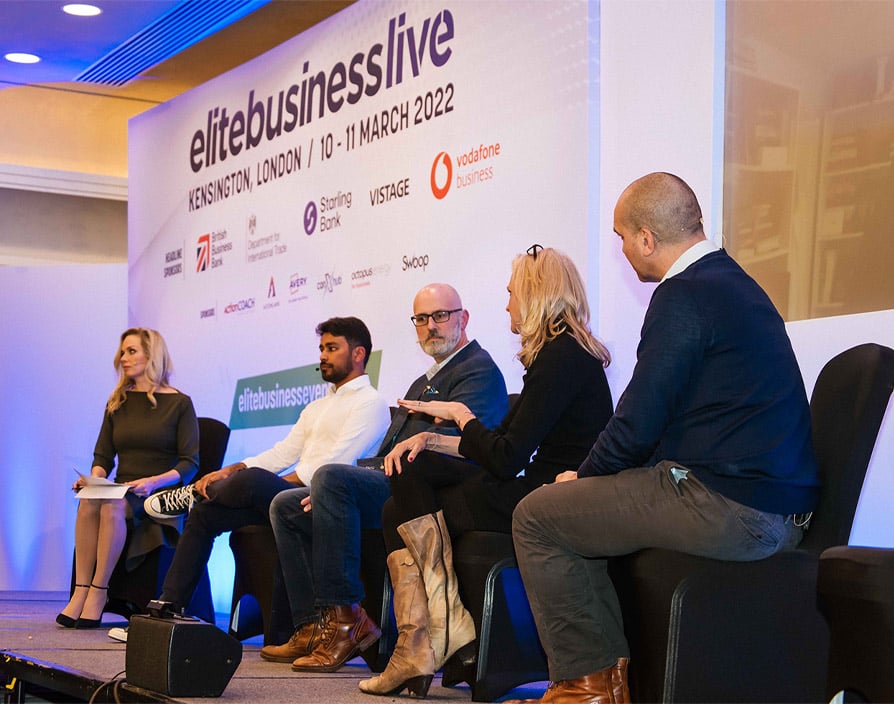Adnan Ahmed, Head of Strategy at Starling Bank, Phil Hobden, Head of Customer Education and Engagement EMEA at Capitalise, Emma Sayle, Founder & CEO of The KK Group and Richard Bearman, the Managing Director of the British Business Bank spoke on the first day of Elite Business on 10 March for the Financial Management panel discussion, talking about the different financial options available for businesses, and touch on their experiences as to how they gained their first big investment – and the trials and tribulations along the way.
There are many options out there for businesses when it comes to managing finances. Whether you decide to bootstrap or find an angel investor, it’s important to understand where you are in your business journey and which financing option is right for you. Getting a loan can be a viable option for SMEs, Adnan explained: “I think a loan is a really good way to not give up control of your business. Getting a loan, you can measure the cost of that you have to return that money and it could be useful for certain activities or certain spurts of growth. If you have a track record behind your business, if you can evidence cash flows it’s a lot easier to get a loan than it is to raise equity from VCs and even from friends and family. But I also would suggest if you have friends and family who can lend you the money you should also use that because you’re never going to get a rate as good as you would from your friends and family than you would from a bank, but of course, there are other considerations with that.”
Emma, founder of the KK group, spoke about her experience with crowdfunding, realising it was the best option for her business due to her large network and community, which was the centre of her business. “We didn’t get any investment for the first decade of running the business, my dad went bankrupt the first way we launched…,” Emma said. “I started the business and events were very much part of it, you could bootstrap and do one event a month, I thought as long as I can just about pay my rent, that was how it was for the first five years. We went down the investment route six years ago because that’s when I looked at the numbers and thought that more than 50% of sales were online, so it’s ‘go big or go home’ time. ‘Me Too’ had just happened, and there was a fire under the bellies of females that had been lit. I felt I could do it having had a decade of building the foundation.”
She added: “We had a big community and membership and massive advocacy and loyalty, and that’s when we made the call to go down the crowdfunding route. So, we went out to the members and we raised funds… In January we made the decision we’re going crowdfunding again. We’ve had £1.5billion pledged, and we’ve got 200,00 members. It reminds you that you can have so many ‘no’s’ and the implication of what you’re doing is ‘wrong’ that you can kind of get very disheartened.”
Less than 2% of venture capital goes to female founders in the US, according to a report by Pitchbook. How are banks addressing the problem? Richard Bearman, the Managing Director of the British Business Bank, spoke about the start-up loans scheme with the British Business Bank: “41% of our loans go to female founders, which among the historic data is a good performance… I think it is a strong performance when we look at the underlying start-up rates. The reason why they’re much more difficult if I had an easy answer there would be an easy solution. I think there’s always that risk of paintbrush comments being made about it, there are lots of factors in it. I think start-up loans particularly, and why they are successful; I think it’s around how the scheme is designed to help not just female founders but many who struggle to access the mainstream system for a variety of reasons. Part of it is working alongside people, it’s not just throwing it into a system or process that may or may not be with barriers or disadvantageous, but having business advisors to work with the founders. The funding is available and it is possible and you can break through some of those challenges.”
Traditional banks versus digital banks – which type of banking is more suitable for your business? Phil Hobden, Head of Customer Education and Engagement EMEA at Capitalise believes digital banks have more options and variety when it comes to lending, filling in the gaps that traditional banks are not able to.“Are traditional banks viable for small businesses? Yes. But are online and digital offerings bringing a new much more innovative way of working? Absolutely,” Phil explained. “Traditional banks will always be there but they’re always typed by specific lending criteria. What I like about the online and digital space, there are so many lenders filling so many niches and so many gaps that big banks don’t do. If you can get a loan from your bank, it’s probably going to be cheaper and on better terms. It’s probably going to be a good loan if you can get it. But for everyone else, there are lenders out there that are creative and innovative. I don’t think small banks are no longer viable, but I think they are facing some serious challenges as they should be. And hopefully, that will force traditional banks to raise their game as well and compete with the digital lenders and the online banks. And then the space will get much better.”
Share via:


















































